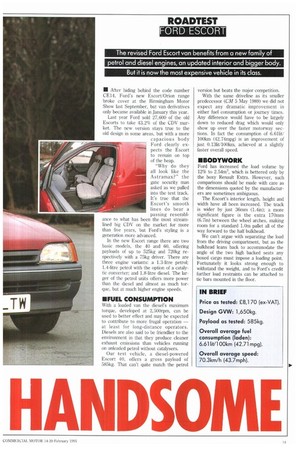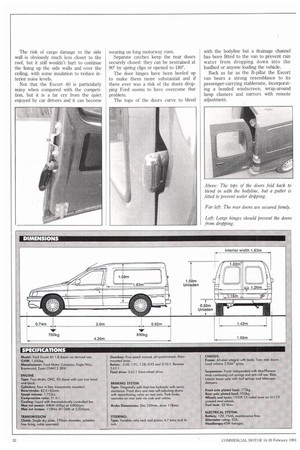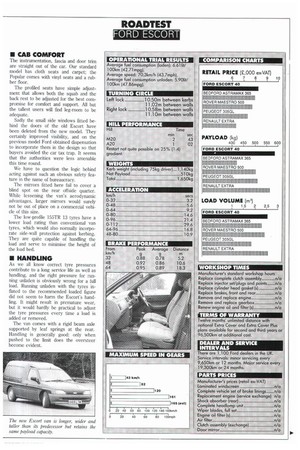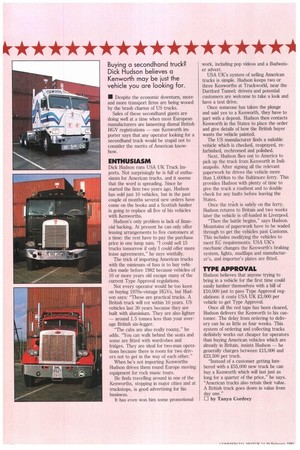ROADTEST FORD ESCORT
Page 33

Page 34

Page 35

Page 36

Page 38

If you've noticed an error in this article please click here to report it so we can fix it.
The revised Ford Escort van benefits from a new family of petrol and diesel engines, an updated interior and bigger body. But it is now the most expensive vehicle in its class.
• After hiding behind the code number CE14, Ford's new Escort/Orion range broke cover at the Birmingham Motor Show last September, but van derivatives only became available in January this year.
Last year Ford sold 27,600 of the old Escorts to take 43.2% of the CDV market. The new version stays true to the old design in some areas, but with a more capacious body Ford clearly expects the Escort to remain on top of the heap.
"Why do they all look like the Astramax?" the gate security man asked as we pulled into the test track. It's true that the Escort's smooth lines do bear a passing resemblance to what has been the most streamlined big CDV on the market for more than five years, but Ford's styling is a generation more advanced.
In the new Escort range there are two basic models, the 40 and 60, offering payloads of up to 525kg and 720kg respectively with a 75kg driver. There are three engine variants: a 1.3-litre petrol; 1.4-litre petrol with the option of a catalytic converter; and 1.8-litre diesel. The larger of the petrol units offers more power than the diesel and almost as much torque, but at much higher engine speeds.
REUEL CONSUMPTION
With a loaded van the diesel's maximum torque, developed at 2,500rpm, can be used to better effect and may be expected to contribute to more frugal operation — at least for long-distance operators. Diesels are also said to be friendlier to the environment in that they produce cleaner exhaust emissions than vehicles running on unleaded petrol without catalysers.
Our test vehicle, a diesel-powered Escort 40, offers a gross payload of 585kg. That can't quite match the petrol version but beats the major competition.
With the same driveline as its smaller predecessor (CM 5 May 1989) we did not expect any dramatic improvement in either fuel consumption or journey times. Any difference would have to be largely down to reduced drag which would only show up over the faster motorway sections. In fact the consumption of 6.611it/ 100km (42.74mpg) is an improvement of just 0.131it/100km, achieved at a slightly faster overall speed.
• BODYWORK
Ford has increased the load volume by 12% to 2.54m3, which is bettered only by the boxy Renault Extra. However, such comparisons should be made with care as the dimensions quoted by the manufacturers are sometimes ambiguous.
The Escort's interior length, height and width have all been increased. The track is wider by just 36mm (1.4in); a more significant figure is the extra 170mm (6.7in) between the wheel arches, making room for a standard 1.0m pallet all of the way forward to the half bulkhead.
We can't argue with separating the load from the driving compartment, but as the bulkhead leans back to accommodate the angle of the two high backed seats any boxed cargo must impose a loading point. Fortunately it looks strong enough to withstand the weight, and to Ford's credit further load restraints can be attached to tie bars mounted in the floor. The risk of cargo damage to the side wall is obviously much less closer to the roof, but it still wouldn't hurt to continue the lining up the side walls and over the ceiling, with some insulation to reduce interior noise levels.
Not that the Escort 40 is particularly noisy when compared with the competition, but it is a far cry from the quiet enjoyed by car drivers and it can become wearing on long motorway runs.
Separate catches keep the rear doors securely closed: they can be restrained at 90° by spring clips or opened to 1800.
The door hinges have been beefed up to make them more substantial and if there ever was a risk of the doors dropping Ford seems to have overcome that problem.
The tops of the doors curve to blend with the bodyline but a drainage channel has been fitted to the van to prevent rain water from dropping down into the loadbed or anyone loading the vehicle.
Back as far as the B-pillar the Escort van bears a strong resemblance to its passenger-carrying stablemate, incorporating a bonded windscreen, wrap-around lamp clusters and mirrors with remote adjustment.
• CAB COMFORT
The instrumentation, fascia and door trim are straight out of the car. Our standard model has cloth seats and carpet; the Popular comes with vinyl seats and a rubber floor.
The profiled seats have simple adjustment that allows both the squab and the back rest to be adjusted for the best compromise for comfort and support All but the tallest users will find leg-room to be adequate.
Sadly the small side windows fitted behind the doors of the old Escort have been deleted from the new model. They certainly improved visibility, and on the previous model Ford obtained dispensation to incorporate them in the design so that buyers avoided the car tax trap. It seems that the authorities were less amenable this time round.
We have to question the logic behind acting against such an obvious safety feature in the name of bureaucracy.
The mirrors fitted here fail to cover a blind spot on the rear offside quarter. While lessening the van's aerodynamic advantages, larger mirrors would surely not be out of place on a commercial vehicle of this size.
The low-profile 155TR 13 tyres have a lower load rating than conventional van tyres, which would also normally incorporate side-wall protection against kerbing. They are quite capable of handling the load and serve to minimise the height of the load bed.
• HANDLING
As we all know correct tyre pressures contribute to a long service life as well as handling, and the right pressure for running unladen is obviously wrong for a full load. Running unladen with the tyres inflated to the recommended loaded figure did not seem to harm the Escort's handling. It might result in premature wear, but it would hardly be practical to adjust the tyre pressures every time a load is added or removed.
The van comes with a rigid beam axle supported by leaf springs at the rear. Handling is generally good: only when pushed to the limit does the oversteer become evident. Despite its longer wheelbase the new Escort van manoeuvres well. The steering is slightly lower geared than the previous model but due to increased steering angles the turning circle is actually tighter.
As with most front-wheel-drive light commercials, hill restarts are not the Escort's strong point. The limiting factor is lack of traction, compounded by the fact that most of the weight is transferred on to the rear axle.
• BRAKING
A large master cylinder and high boost pressure give good control of the ventilated front disc and rear drum brakes. On a dry track with high pedal pressure we achieved good deceleration figures without the wheels locking.
A load apportioning valve is fitted to the rear axle to prevent overbraking when running without a load.
Single-piston calipers on outboard discs should prove easy to maintain, and the sealed-for-life rear hubs, fitted with "Setright" tapered roller bearings, need not be disturbed during rear brake maintenance.
A look below the bonnet shows that all the filler points are within easy reach and highlighted in yellow for instant recognition. Our test vehicle looked as though it had been standing for some time; it was clean and free of oil leaks, but the cadmium plating on the fuel pump controls and fuel pipes was already showing signs of corrosion.
• SUMMARY
The Escort 40 is the most expensive van in its class, but costs only £200 more than the Astramax, which has been around for several years, and only 2400 more than Rover's Maestro, which has a technically superior DI diesel but lacks the Escort's new-generation body styling.
For £1,835 less, however, the Renault Extra offers exceptional value for its volume and payload capacity, but lacks the Ford's comfort.
The latest Escort car styling blends very well with the commercial bodywork and is longer, higher and wider than the model it replaces without sacrificing payload. Interior improvements include tie bars, a half bulkhead and lower panel trim with more floor space between the wheel arches. The front end shares the passenger car improvements, including lighter steering and brakes, a neat new fascia and wide doors. With correctly inflated tyres the vehicle handles and rides well, but there must be some question on the tyre specification for hard commercial use.
by Bill Brock
• Despite the economic downturn, more and more transport firms are being wooed by the brash charms of US trucks.
Sales of these secondhand giants are doing well at a time when most European manufacturers are lamenting dismal British HGV registrations — one Kenworth importer says that any operator looking for a secondhand truck would be stupid not to consider the merits of American knowhow.
ENTHUSIASM
Dick Hudson runs USA UK Truck Imports. Not surprisingly he is full of enthusiasm for American trucks, and it seems that the word is spreading. Since he started the firm two years ago, Hudson has sold just 10 vehicles, but in the past couple of months several new orders have come on the books and a Scottish haulier is going to replace all five of his vehicles with Kenworths.
Hudson's only problem is lack of financial backing. At present he can only offer leasing arrangements to five customers at a time: the rest have to pay the purchase price in one lump sum. "I could sell 15 trucks tomorrow if only I could offer more lease agreements," he says wistfully.
The trick of importing American trucks with the minimum of fuss is to buy vehicles made before 1982 because vehicles of 10 or more years old escape many of the current Type Approval regulations.
Not every operator would be too keen on buying 1970s-vintage HGVs, but Hudson says: "These are practical trucks. A British truck will rot within 10 years. US vehicles last 30 years because they are built with aluminium. They are also lighter — around 1.5 tonnes less than your average British six-legger, "The cabs are also really roomy," he adds. "You can walk behind the seats and some are fitted with wardrobes and fridges. They are ideal for two-man operations because there is room for two drivers not to get in the way of each other."
When he's not importing Kenworths Hudson drives them round Europe moving equipment for rock music tours.
He finds travelling around in one of the Kenworths, stopping in major cities and at truckstops, is good advertising for his business.
It has even won him some promotional work, including pop videos and a Budweiser advert.
USA UK's system of selling American trucks is simple. Hudson keeps two or three Kenworths at Truckworld, near the Dartford Tunnel; drivers and potential customers are welcome to take a look and have a test drive.
Once someone has taken the plunge and said yes to a Kenworth, they have to part with a deposit. Hudson then contacts Kenworth in the States to place the order and give details of how the British buyer wants the vehicle painted.
The US manufacturer finds a suitable vehicle which is checked, resprayed, refurbished, rechromed and polished.
Next, Hudson flies out to America to pick up the truck from Kenworth in Indianapolis. After signing all the relevant paperwork he drives the vehicle more than 1,6001cm to the Baltimore ferry. This provides Hudson with plenty of time to give the truck a roadtest and to double check for any faults before leaving the States.
Once the thick is safely on the ferry, Hudson returns to Britain and two weeks later the vehicle is off-loaded in Liverpool.
"Then the battle begins," says Hudson. Mountains of paperwork have to be waded through to get the vehicles past Customs. This includes modifying the vehicles to meet EC requirements. USA UK's mechanic changes the Kenworth's braking system, lights, mudflaps and manufacturer's, and importer's plates are fitted.
TYPE APPROVAL
Hudson believes that anyone trying to bring in a vehicle for the first time could easily lumber themselves with a bill of £10,000 just to pass Type Approval regulations: it costs USA UK £3,000 per vehicle to get Type Approval.
Once all the red tape has been cleared, Hudson delivers the Kenworth to his customer. The delay from ordering to delivery can be as little as four weeks. This system of ordering and collecting trucks definitely works out cheaper for operators than buying American vehicles which are already in Britain, insists Hudson — he generally charges between £15,000 and £23,500 per truck.
"Instead of a customer getting lumbered with a £55,000 new truck he can buy a Kenworth which will last just as long for a quarter of the price," he says. "American trucks also retain their value. A British truck goes down in value from day one."
by Tanya Cordrey








































































































